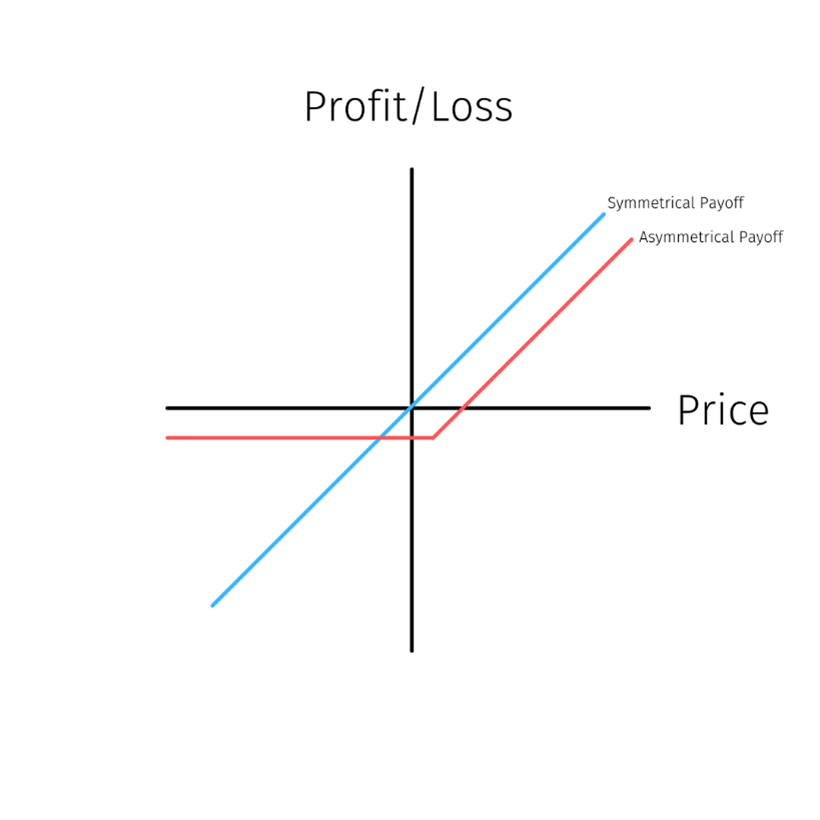The Pursuit of Asymmetric Returns
March 5, 2022
AUTHOR: ADMIN
“The essence of investment management is the management of risks, not the management of returns.” –Benjamin Graham
Understanding Asymmetric Returns
For a typical investor who primarily invests in stocks, the probability of the investment generating a certain amount of profit is the same as the probability of taking a loss of an equal amount. This scenario is known as a linear or symmetric return profile.
In the investment management world, an important concept called asymmetric returns refers to a disparity in the risk-reward profile of an investment, which could either be favourable or unfavourable to an investor. Favourable asymmetric returns occur when the upside potential is greater than the downside risk. In other words, the probability that you have a positive outcome is higher than the probability of a negative outcome. The opposite is true for unfavourable asymmetric returns.
Below is a visual comparison of symmetrical & asymmetrical returns.

How Asymmetric Returns Can Benefit Investors
As an investor, generating favourable asymmetric returns is important because your investment returns are more likely to be positive than negative in this type of investment. If you have a number of these types of investments, over time, your losses, when they happen, are smaller and less frequent, and your wins are more significant and more frequent. The result is more money in your investment account over time than if you had only symmetric returns, where dollar-weighted probabilities of loss or gain are equal.
How Can Investors Pursue Asymmetric Returns?
- Options contracts: Options are derivatives that grant the holder the right, but not the obligation, to either purchase or sell an underlying instrument (equity, debt, etc) at a set price. As the price of purchasing the option is usually a small fraction of the price of the underlying instrument, it allows potential exposure to great gains from the underlying instrument, while only risking the relatively small price of the option in return.
- Bonds with positive convexity: Convexity measures the sensitivity of a bond’s duration to changes in yields. If a bond’s duration rises while yields fall, the bond is said to have positive convexity meaning that as yields decline, the bond price will increase by a more considerable amount than it would lose if yields rose. The opposite is true with negative convexity. Adding bonds or bond portfolios with positive convexity would give the investor an asymmetric return profile where the potential upside is more significant than the downside.
- Flow-through investing: A flow-through share is a type of share in a Canadian resource company which allows the company to “flow-through” its expenses to the investor. The investor then uses this as a deduction of their income for tax purposes, which creates asymmetry because the deduction provides an immediate cash advantage to the investor and lowers the breakeven point to less than 50% of the original investment value (assuming the investor is in the highest marginal tax bracket, at greater than 50%). In addition, cash returned to investors is only taxed at the capital gains rate – effectively half of the rate at which you deducted the investment in the first place. Pavilion Resource Fund, by Accilent Capital Management, is an example of a flow-through fund that pools investors’ money to purchase a diverse range of flow-through shares.
Disclaimer
The information provided is general in nature and is provided with the understanding that it may not be relied upon as, nor considered to be, the rendering of tax, legal, accounting, or professional advice. Readers should consult with their own accountants and/or lawyers for advice on the specific circumstances before taking any action. Accilent Capital Management Inc. (“Accilent”) is the investment manager to the Pavilion Flow-Through L.P.s (collectively, the “Funds”). This document is for information purposes only and should not be relied upon as investment advice. We strongly recommend that you consult your investment professional for a comprehensive review of your personal financial situation before undertaking any investment strategy. Information herein is subject to change without notice and Accilent is not responsible for any inaccuracies or to update this information. The information contained herein does not constitute an offer or solicitation by anyone in the United States or in any other jurisdiction in which such an offer or solicitation is not authorized or to any person to whom it is unlawful to make such an offer or solicitation. Prospective investors who are not resident in Canada should contact their financial advisor to determine whether securities of the Funds may be lawfully sold in their jurisdiction.